URGENT!
Due to the weather, we are experiencing intermittent power outage and loss of internet. Please expect delays and or rescheduling of appointments during this time. We will reach out to you as soon as we can. Stay warm and stay safe!
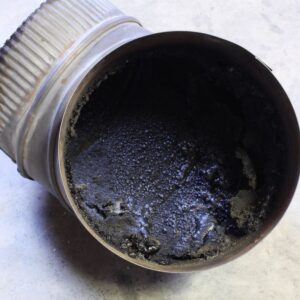 Managing the cleanliness of a chimney is an ongoing maintenance requirement for those who have wood burning fireplaces and stoves. It’s not just about looks, but about safety. Left alone, chimneys will begin to accumulate soot and creosote, as well as potential debris, and these can act as fire hazards and create issues with ventilation.
Managing the cleanliness of a chimney is an ongoing maintenance requirement for those who have wood burning fireplaces and stoves. It’s not just about looks, but about safety. Left alone, chimneys will begin to accumulate soot and creosote, as well as potential debris, and these can act as fire hazards and create issues with ventilation.
What exactly is creosote? It’s a dark, tarry substance that is produced as a result of burning wood or other organic materials. Creosote consists of various chemicals including tar, soot, and other volatile organic compounds – and it is highly combustible. Untended, it drastically increases the risk of chimney fires and can eventually find its way into your living space. Over time, it becomes more stubborn and difficult to get out of your chimney. Thus, the necessity of having it frequently removed.
Enter the creosote burning log. This is a product designed to help keep your chimney cleaner. But does it work?
Creosote burning logs, also marketed as “chimney cleaning logs” or “creosote sweeping logs,” are specially formulated logs that claim to reduce or eliminate creosote buildup in chimneys and stovepipes. They are typically made from a combination of sawdust, paraffin wax, and other additives and work as a chemical cleaner.
When burned in a wood burning appliance, the chemicals they release are designed to react with creosote and help break it down. The idea is that this chemical attack will make creosote loose, flaky, and easy to remove.
So, do creosote logs live up to the hype? The answer is a qualified yes – in other words, it is effective in some ways, but you will want to be sure you’ve managed your expectations. If you’re expecting a totally clean chimney with no other effort expended, you’ll be disappointed. However, creosote logs do have an effect on creosote.
As a chemical cleaner, creosote logs will do some work at making creosote more removable and cause some – maybe much – of the creosote to flake away. Because creosote is tough, this can be a really useful step towards a clean flue!
But it won’t actually remove or stop creosote from forming. You’ll have to give due diligence to carefully removing any flaked creosote from your firebox, flue, smoke chamber, or thimble area, since it can be a hazard in your home environment.
And keep in mind that since burning a creosote log becomes an unguided process, once the smoke starts moving up the flue, you don’t have control over where flaked creosote goes or how much is removed. It can drift into bends or other hard-to-access areas of your chimney system, possibly moving – but not eliminating – the problem.
Creosote burning logs should never be viewed as a substitute for professional chimney sweeping. While they may help reduce creosote buildup to some extent, they aren’t a comprehensive solution to chimney maintenance. Having an experienced, CSIA certified technician sweep your chimney remains essential because:
Creosote burning logs are deemed safe for use in your fireplace by the Chimney Safety Institute of America (CSIA). But while they offer some benefits in terms of reducing creosote buildup – and aren’t hazardous in themselves – it can be hazardous to put too much faith in them and therefore overlook their limitations.
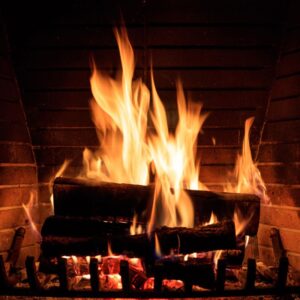 One such limitation is their overall effectiveness. The efficacy of creosote burning logs can vary depending on a number of factors, such as how often you use your fireplace, the type of wood burned, appliance design, and chimney configuration. If heavy buildup is already present or creosote is of a particularly stubborn composition, these logs may not effectively break it down. And without a careful assessment, it will be nearly impossible to know whether burning the log has been adequately successful or not. And if it hasn’t, the risks remain in play.
One such limitation is their overall effectiveness. The efficacy of creosote burning logs can vary depending on a number of factors, such as how often you use your fireplace, the type of wood burned, appliance design, and chimney configuration. If heavy buildup is already present or creosote is of a particularly stubborn composition, these logs may not effectively break it down. And without a careful assessment, it will be nearly impossible to know whether burning the log has been adequately successful or not. And if it hasn’t, the risks remain in play.
Keep in mind as well that while creosote logs are formulated to attack creosote, they aren’t necessarily removing any other type of blockage. So if leaves, twigs, or other types of debris have made their way into your flue, burning a creosote log won’t address these and lead to safe ventilation.
While the accumulation of creosote is accelerated by burning firewood that’s not properly seasoned (such as damp or green wood), even clean-burning wood fires will eventually contribute to build up because combustion will never be one hundred percent complete each time. So for those who use wood-burning appliances, diligent removal will be the best strategy for managing creosote.
Burning creosote logs can offer a supplementary approach to reducing creosote deposits in chimneys and stovepipes, but they can’t replace professional maintenance, including your chimney sweeping. Homeowners should continue to prioritize regular chimney maintenance – think inspections and sweepings – performed by certified professionals to help mitigate risks, maintain efficiency, and protect their investment in their home.
If you need chimney care, book with Lords Chimney today by calling or reaching out online. We’ve got your back.
Chimney fires are no joke. Each year there are approximately 25,000 chimney fires in the United States. These fires cause over $100 million in property damages and can lead to injury and even death. A fast-burning chimney fire can quickly cause your chimney liner to expand and crack, exposing and igniting combustibles in your home. This can happen in an instant so it’s important to know what causes these fires, how to prevent them, and what you should do if you have one.
With over 17 years of experience providing the great Houston area the highest quality chimney, fire place, and dryer vent services, Lords Chimney has a wealth of chimney wisdom to share with you.
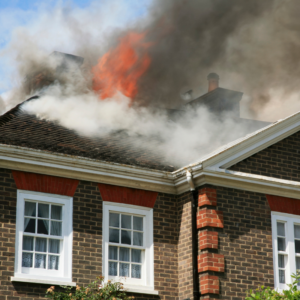 The most common cause of a chimney fire is creosote accumulation in an unclean chimney. When you have a fire in your fireplace, you are causing a chemical reaction. It is this reaction that turns wood to ash and sends byproducts up the chimney. Two of those things that result from these byproducts are soot and creosote. When you see black and sometimes even greasy-looking spots on the masonry in your fireplace, you are looking at soot and creosote.
The most common cause of a chimney fire is creosote accumulation in an unclean chimney. When you have a fire in your fireplace, you are causing a chemical reaction. It is this reaction that turns wood to ash and sends byproducts up the chimney. Two of those things that result from these byproducts are soot and creosote. When you see black and sometimes even greasy-looking spots on the masonry in your fireplace, you are looking at soot and creosote.
Soot needs to be cleaned, but the real danger lies in the creosote. Creosote is a black or brown substance that can be flaky or sticky, tar-like or shiny – and the more you burn, the more creosote can build up. If it is regularly removed, creosote comes off easily. If it is allowed to build up, creosote can harden and glaze, becoming an ever bigger danger to the chimney owner.
Creosote is extremely combustible. It will ignite at 451 degrees. Many fireplace fires will burn at 450 degrees which means that it doesn’t take much to turn that creosote into a burning chimney fire that threatens your chimney, house, and life. Because it is a natural byproduct of burning, creosote is going to accumulate over time, but there are ways to slow its accumulation and drastically lower the risk of fire in your chimney.
What can you do to slow down creosote accumulations?
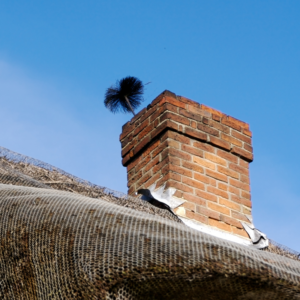 The easiest way to slow the buildup of creosote is to make sure the fuel of your fire burns efficiently. This means that properly dried and seasoned firewood is your best choice when creating that cozy fire. Moisture in your firewood creates an inability to burn completely leaving wasteful byproducts traveling up your chimney and sticking to the walls.
The easiest way to slow the buildup of creosote is to make sure the fuel of your fire burns efficiently. This means that properly dried and seasoned firewood is your best choice when creating that cozy fire. Moisture in your firewood creates an inability to burn completely leaving wasteful byproducts traveling up your chimney and sticking to the walls.
Freshly chopped firewood will usually have around 50% moisture content. It is heavy and sometimes you will even be able to see some green coloring in the wood itself. The firewood you burn should have a moisture content of no more than 25%.
Before burning, do a quick visual and audible inspection of your wood. It should be light in color and light in weight with no visible green coloring. When you knock two pieces together you should hear a clear clunk rather than a low, dull, thud. These visual and audible cues can let you know whether you are going to be quickly adding to your creosote buildup or efficiently burning the safest fuel.
Your chimney should have a liner on the inside walls that is made to protect the chimney from creosote buildup. Liners improve the airflow and efficiency of your fireplace which means a safer home for you. Make sure your liner is inspected every year.
Our team at Lords Chimney are experts at sizing, installing, and caring for chimney liners. A simple phone call to one of our experts at Lords Chimney is the best way to make sure your liner is doing everything it’s meant to do.
Make sure you are taking care to keep that chimney damper open along with any doors that might be on the front of your fireplace. Your chimney was likely installed with a specific airflow in mind. Check the operator’s manual and make sure you’re using your fireplace how it was built to be used.
The best way to make sure your chimney is safe is by having a chimney technician from Lords Chimney sweep and inspect it. Our experts are certified, equipped, and trained to get rid of that creosote and leave your chimney clean and ready to use. We are happiest when you are safe and happy. There is simply no better way to keep that creosote at bay.
While creosote is the most common instigator of chimney fires it is important to keep an eye out for things in your chimney that just shouldn’t be there. Because it is dry, warm, and protected from wind, an unprotected chimney can quickly collect blowing debris and become home to unwanted animals.
The easiest way to avoid debris and animal homes clogging up your chimney is to make sure that you have a properly fitting chimney cap installed. A chimney cap is great at keeping out unwanted creatures, leaves, sticks, and other rooftop invaders. It also allows air to continue to flow properly. As your go-to chimney experts, Lords Chimney is ready to install the perfect cap protection for your chimney.
Lords Chimney is certified by the Chimney Safety Institute of America (CSIA), and we have established a reputation in our community for providing the most professional chimney services you can find. Your safety is important to us. Call or book online today to schedule an appointment with one of our chimney technicians and get your chimney clean and healthy.
If you’ve ever noticed any gummy-looking black stuff in your chimney, chances are it’s creosote. This dark residue is a byproduct of burning wood and it sticks to the inner walls of chimneys. It can be either flaky, shiny, or sticky.
And since creosote forms through burning wood, it is naturally prone to catching on fire. As such, the Chimney Safety Institute of America (CSIA) highlights its high combustibility as a primary safety concern.
Yes! Creosote is a combustible byproduct that can easily catch fire. And once it ignites, it can quickly spread through the chimney, causing the liner to break down and the masonry to crumble and crack. This means any future fires you light will be more prone to escape the chimney walls and enter your home.
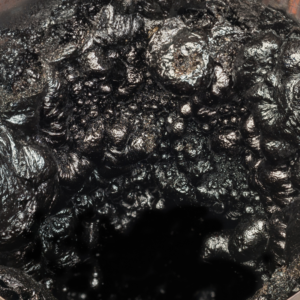 Creosote can also accumulate until it clogs the flue. This blocks the free flow of gases and smoke causing problems with drafting and airflow to develop. This hinders efficiency levels, and it puts you more at risk of being exposed to hazardous fumes, like smoke from your fires or even carbon monoxide – a deadly and extremely hard-to-detect gas.
Creosote can also accumulate until it clogs the flue. This blocks the free flow of gases and smoke causing problems with drafting and airflow to develop. This hinders efficiency levels, and it puts you more at risk of being exposed to hazardous fumes, like smoke from your fires or even carbon monoxide – a deadly and extremely hard-to-detect gas.
Considering the health and safety hazards that creosote poses, regular chimney sweepings become a critical obligation. Professional chimney sweeps have the right equipment to assess any chimney’s condition and address creosote buildup before it becomes a problem.
While creosote isn’t unavoidable, there are ways to effectively reduce accumulation in your flue:
Most chimney fires move slowly and don’t produce a lot of noise, which means you may have had one without noticing. The CSIA identifies the following signs that your chimney could have survived fire before:
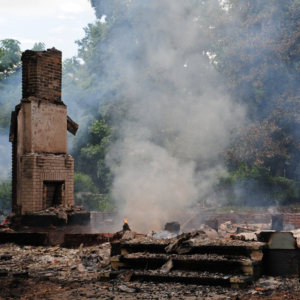 Black or dark-brown byproducts in chimney walls or fireplace
Black or dark-brown byproducts in chimney walls or fireplaceIf you do notice that a chimney fire is currently occurring, exit the home immediately and get in touch with your local fire department as soon as possible. In addition, as you are leaving your home, the CSIA suggests closing the door behind you if you can. The goal is to prevent any more air from feeding the flames until the fire department arrives.
Even if you believe that your chimney is functioning correctly, there could be hazards hiding away, ready to cause issues. Scheduling a chimney inspection is one way to gain peace of mind, during which we can determine if you need a sweeping.
Creosote is a dangerous byproduct that you might fail to notice immediately. This material is combustible and can cause health and fire hazards in your home. To effectively avoid this issue, we suggest getting in touch with one of our CSIA certified chimney sweeping experts to inspect and clean your chimney. Schedule an inspection today!
If you find yourself wondering about chimney inspections, sweepings, and more, check out some of the more common inquiries we get by reading below.
 Most people start thinking about scheduling their inspection right around the time school starts and people start bringing out pumpkin decor. When fall is just around the corner, families start planning for the holidays, and homeowners suddenly realize that they better make sure their fireplaces are in good working order.
Most people start thinking about scheduling their inspection right around the time school starts and people start bringing out pumpkin decor. When fall is just around the corner, families start planning for the holidays, and homeowners suddenly realize that they better make sure their fireplaces are in good working order.
Unfortunately, because everyone tends to think the same thing at the same time, we get a lot of appointment requests throughout September, October, and November. That means, as things fill up, repairs and inspections will book out later and later as the year progresses – and if you want a well-working fireplace by Thanksgiving and Christmas, it’s much more likely to happen if you get in touch with us on the earlier side.
Long story short: We recommend staying ahead of the curve by scheduling your inspection during late spring or early summer. May, June, and July are all ideal months to get your maintenance booked in a timely manner, and you’ll be more likely to get your appointment on a day and time that’s convenient for you.
There are three different levels of chimney inspection designated by the Chimney Safety Institute of America (CSIA). A CSIA-certified chimney sweep can help advise you on what level of chimney inspection your home needs.
The National Fire Protection Association Standard (NFPA) 211 says, “chimneys, fireplaces, and vents shall be inspected at least once a year for soundness, freedom from deposits, and correct clearances.“
Yes – an inspection should be completed every year to ensure optimal functioning. This way if there are small problems (like a small leak, crack, etc.), we can catch them while they are still minor and relatively easy to fix. If you wait until the issues are big and obvious, they will be much more expensive and time-consuming to fix.
Hiring a certified chimney professional is always your best bet and ensures you don’t wind up paying more for the home than you should. And you’ll have all of your bases covered when it comes to insurance, too – well worth it!
All in all, preventative maintenance is always better on your budget, schedule, and stress levels, so don’t hesitate to get that yearly inspection on the books!
The short answer here is… both! If you put your fireplace to lots of use, then you’ll definitely want it checked over for damages and build-up because both of these things can lead to some serious and dangerous issues down the line.
But bad weather will often lead to some major problems, too. Hurricanes, tornadoes, and the like can compromise your structural integrity a great deal, and by documenting your structure both before and after a natural disaster, you ensure your tracks are covered when it comes to getting compensation from your insurance company.
Other than experiencing a chimney fire, most signs of creosote build-up aren’t all that obvious. You won’t truly know where you are at until you get an official inspection completed by a team of qualified sweeps.
When it comes to creosote sweeping logs, the name can be a bit deceiving. While they can make the creosote in your chimney easier for the professional to remove, they don’t actually remove the harmful substance.
These products should never replace an actual professional sweeping, and they will not clean your chimney. All in all, they’re not bad for your chimney, but they may not be worth the money you pay for them.
There are a few main things to keep in mind when hiring a sweep.
If you are moving out of a house with a chimney, moving into one with a chimney, or both, scheduling a level 2 inspection is necessary before any final decisions are made. This more in-depth look into your chimney will ensure all parts are working properly, and that no extra repairs are needed before the buying or selling process begins.
We want to help all of your major life transactions go as smoothly as possible. Invest in an inspection from us and get the guidance and reassurance you deserve!
When it comes to providing you with quality service, the staff at Lords Chimney goes above and beyond – and we check all the boxes.
All in all, here at Lord’s Chimney, we believe communication is a key component in quality customer service, which is why you get an actual picture or video of the technician that is coming to your home, along with their certifications.
You can bet that we’ve got everything necessary to provide you with the highest level of care, so don’t hesitate to reach out now.
Call or book online today.
With our busy season coming to a close, now is an ideal time to get your inspection, sweeping, or repair work scheduled. There are countless benefits to schedule chimney care this time of year, so get in touch Lords Chimney right away. We are always happy to help you out!

If you feel that free time is something that is hard to come by in your family, then you are not alone. We understand that your to-do list is long and many struggle when it comes to scheduling regular professional chimney care. Unfortunately, putting this maintenance on the back burner can lead to some serious risks.
That’s why we always aim to come at a time that is convenient for you, which is why we suggest getting your inspection in now while our schedule is more clear. This availability means you will have the freedom to schedule your appointment at a time that works well for you. No need to rearrange your hectic schedule! Just let us know what works, and we can schedule it.
Another big advantage of scheduling your chimney maintenance now is that we will be able to tackle any repairs right away. During the fall, repairs may need to be put on hold until our scheduled clears up. Throughout fall and early winter we stay very busy, so addressing repairs can take more time than usual, putting off your burn season. If we spot damages we can repair them now so you will be able to light up a fire early! While others are struggling to get maintenance completed, you will be ready to enjoy nights by a fire.
All in all, regular inspections are never something to put off, and now is an ideal time to get yours completed. Skipping this maintenance could land you in some trouble when the time comes to light a fire. Using a system that is damaged or clogged increase your chances of experiencing chimney fires, gas leaks, and house fires.
Along with this, a chimney that is well cared for will run more efficiently, guaranteeing you more heat and a more pleasant aesthetic, overall.
Guarantee yourself a safer and more comfortable home by getting the care you deserve right away. The team at Lords Chimney is experienced, CSIA certified, and eager to provide you with top-notch customer care. Schedule an appointment online today. We’ll be happy to help you out right away!